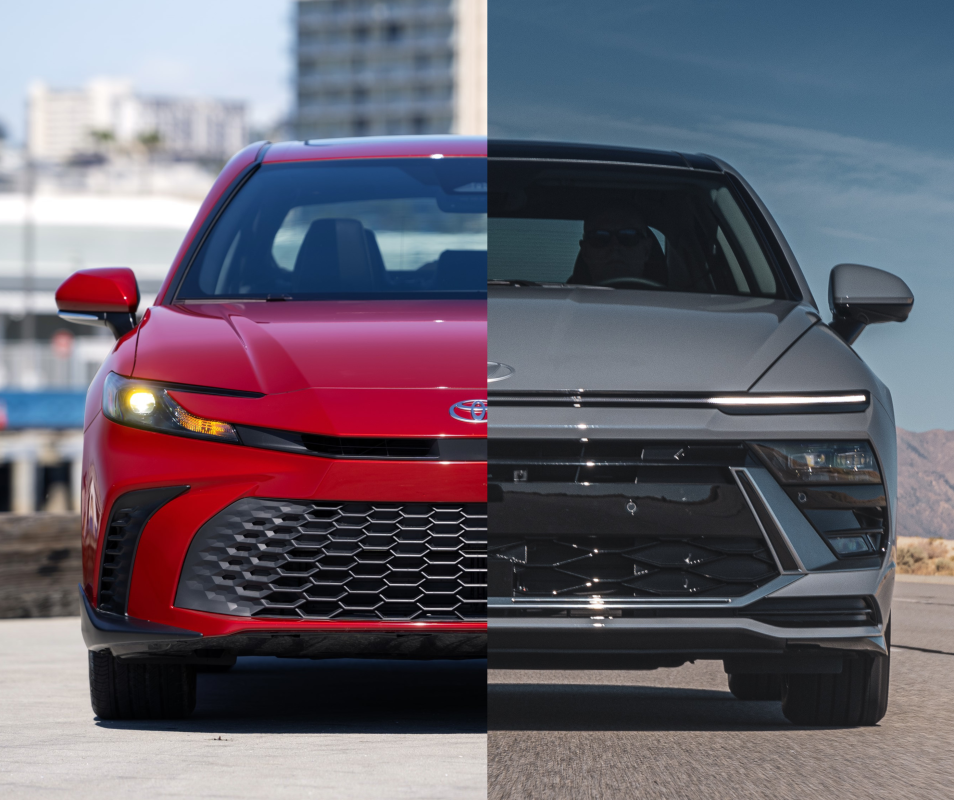The midsize sedan market is shrinking, but two stalwarts, the Toyota Camry and Hyundai Sonata, are fighting to stay relevant. Both received significant updates for 2025, offering compelling options for buyers who still prefer the practicality and efficiency of a sedan over the ubiquitous crossover. Here’s a breakdown of five key differences between these two redesigned models:
Hybrid Powertrains: Toyota Commits, Hyundai Offers Choice
The most significant change to the 2025 Toyota Camry is its exclusive focus on hybrid powertrains. Toyota has eliminated traditional gasoline-only engines, making every 2025 Camry a hybrid. The standard setup combines a 2.5-liter four-cylinder engine with two electric motors, producing a combined 225 horsepower. All-wheel-drive (AWD) models add a third electric motor to the rear axle, boosting total output to 232 hp. This makes the Camry a unique offering: a hybrid sedan with available all-wheel drive.
Hyundai takes a different approach with the 2025 Sonata. Buyers can still opt for a traditional, non-hybrid powertrain: a 2.5-liter four-cylinder engine producing 191 horsepower and 181 lb-ft of torque. The Sonata Hybrid pairs a 2.0-liter engine with an electric motor, delivering a combined 192 horsepower. While slightly less powerful than the Camry Hybrid, the Sonata Hybrid prioritizes smooth and efficient operation. The key takeaway: Camry buyers are committed to a hybrid, while Hyundai provides a choice.
Pricing and Value: A Close Comparison
The 2025 Hyundai Sonata SE starts at $26,900, with the SEL trim around $28,000. The base 2025 Camry LE Hybrid starts at $28,700 for front-wheel drive and $30,225 for all-wheel drive.
While the official price for the most efficient Sonata Hybrid (the Blue trim) is not yet available for 2025, the mid-tier SEL Hybrid starts at $31,250, and the top-tier Limited Hybrid reaches $37,700. The Camry’s upper trims are similarly priced: the XLE Hybrid AWD at $35,125 and the XSE AWD Hybrid at $36,425.
For hybrid-to-hybrid comparisons, the pricing is competitive. The Camry offers standard hybrid power and optional AWD, while the Sonata is slightly less expensive in its mid-level trims. However, fully equipped models are priced similarly. It’s crucial to consider real-world incentives and dealer discounts, which can significantly impact the final price, especially for Hyundai.
All-Wheel Drive: Camry’s Exclusive Advantage
A significant advantage for the 2025 Camry is its available electric all-wheel-drive system. This isn’t just a novelty feature; it provides enhanced traction and stability, particularly in snowy or icy conditions. The Camry’s AWD system uses an electric motor to power the rear wheels independently, eliminating the need for a traditional mechanical driveshaft. This seamless system doesn’t noticeably affect fuel economy.
The 2025 Sonata, in both gasoline and hybrid versions, remains front-wheel-drive only. While this might not be a concern for drivers in warmer climates, it’s a notable disadvantage in regions where all-wheel drive is highly valued for winter driving. If AWD is a priority, the Camry is the clear choice.
Interior Design and Technology: Hyundai’s Modern Edge
Both sedans have made strides in interior design and technology, but the Sonata’s cabin exudes a more modern and premium feel. Hyundai offers a dual 12.3-inch display setup, combining the digital gauge cluster and infotainment screen under a single curved glass panel. The layout is clean, intuitive, and upscale, especially in higher trims. Even base models feel contemporary, thanks to Hyundai’s user-friendly interface and standard wireless Apple CarPlay and Android Auto.
The 2025 Camry’s interior is a significant improvement, but the level of technology varies by trim. LE and SE models feature an 8-inch touchscreen and a 7-inch digital gauge display. Upgrading to the XLE or XSE unlocks the dual 12.3-inch display setup. Like the Sonata, Toyota offers wireless smartphone mirroring and a premium JBL sound system on higher trims.
Overall, Hyundai has an edge in standard features and presentation. The Sonata Limited Hybrid even includes ventilated front seats, a head-up display, and Highway Driving Assist – Hyundai’s semi-automated driving system – which is unavailable on the Camry.
Performance and Ride Comfort: Different Priorities
The Camry, with up to 232 horsepower and available AWD, offers stronger performance on paper. It accelerates quickly for a hybrid sedan and, in XSE trim, provides sportier handling thanks to a firmer suspension. Toyota has clearly aimed to retain some of the enthusiast appeal previously offered by the now-discontinued V6 engine.
The Sonata Hybrid, with its 192-hp system, prioritizes smoothness over outright speed. Hyundai’s focus on comfort results in a quieter cabin, a more compliant ride, and reduced harshness over rough roads. It’s designed for comfortable commutes and long drives.
Fuel economy is comparable between the two. The Camry LE Hybrid achieves up to 51 mpg combined, while AWD models get 47–48 mpg. The Sonata Hybrid ranges from 47 to 52 mpg, depending on trim and wheel size.
Choosing the Right Sedan
Both the 2025 Toyota Camry and Hyundai Sonata are excellent midsize sedans, each catering to slightly different priorities.
The Camry is the better option for those who want a hybrid-only powertrain, available all-wheel drive, and more power. It’s also a good choice for drivers in colder climates who need extra traction. The Sonata is a better fit for those who value sleek technology, a more comfortable ride, and the option of a gasoline-only engine. It also tends to offer slightly better value at most trim levels.
In a segment that many automakers are abandoning, the redesigned Sonata and Camry demonstrate that the midsize sedan still has much to offer, with impressive fuel economy, thoughtful design, and a wealth of standard technology.


